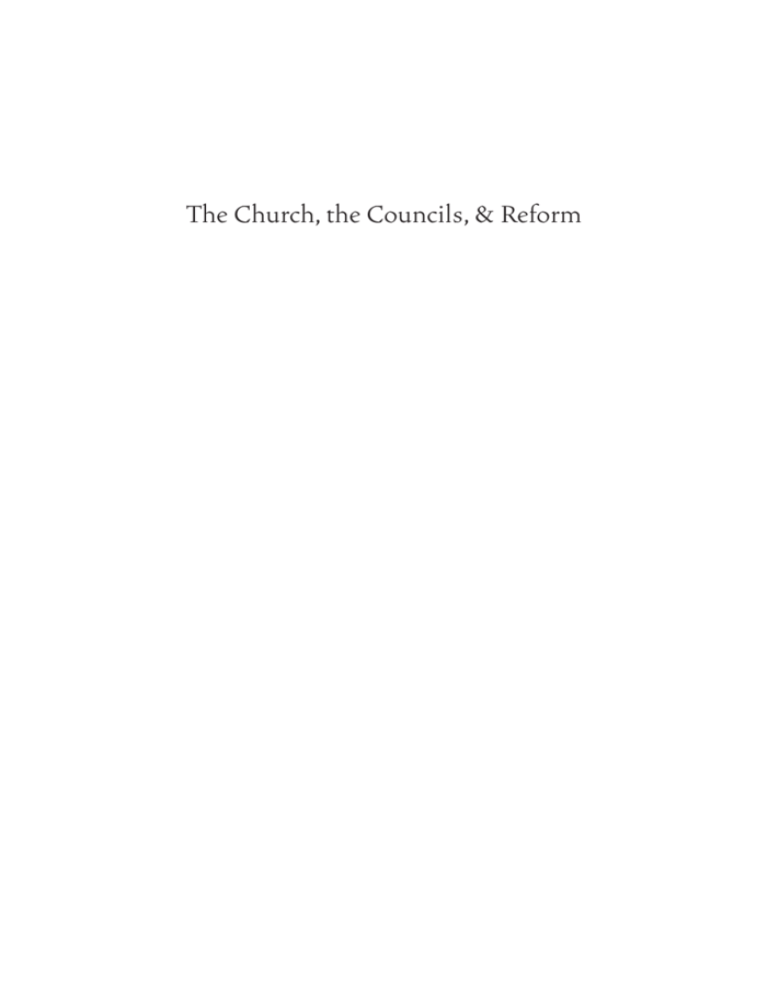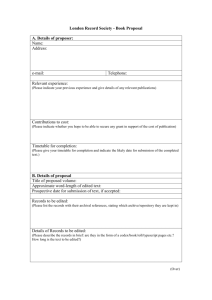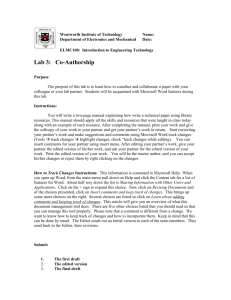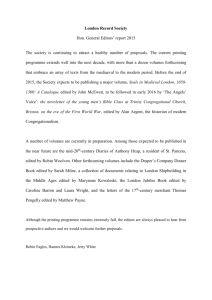
The Church, the Councils, & Reform
The Church, the Councils,
& Reform
The Legacy of the Fifteenth Century
Edited by Gerald Christianson, Thomas M. Izbicki,
and Christopher M. Bellitto
T h e Cath olic U n iver sity of America Press
Washington, D.C.
Copyright © 2008
The Catholic University of America Press
All rights reserved
The paper used in this publication meets the minimum requirements of American
National Standards for Information Science—Permanence of Paper for Printed
Library Materials, ANSI Z39.48-1984.
∞
Designed by Kachergis Book Design of Pittsboro, North Carolina
Printed by Thomson-Shore of Dexter, Michigan
Libra ry o f C o n g re s s Cata l o g i n g -i n - P u b l i cat i on D ata
The church, the councils, and reform : the legacy of the fifteenth century / edited by
Gerald Christianson, Thomas M. Izbicki, and Christopher M. Bellitto.
p. cm.
Includes bibliographical references and index.
ISBN 978-0-8132-1527-3 (cloth : alk. paper) 1. Church history—15th century. I. Christianson, Gerald. II. Izbicki, Thomas M. III. Bellitto, Christopher M. IV. Title.
BR305.3.C49 2008
270.5—dc22
2007045814
To our tea che rs,
Bernard McGinn
Brian Tierney
Louis B. Pascoe, S.J.
}
That which we have heard and known,
And what our forebears have told us,
We will not hide from their children.
—Psalm 78:3
Contents
Preface
Abbreviations
Introduction / The Conciliar Tradition and Ecumenical Dialogue Gerald Christianson
Pa r t I . Hist orical Perspec ti ve s
Introduction
Thomas M. Izbicki
1. Councils of the Catholic Reformation: A Historical Survey
Nelson H. Minnich
2. Aeneas Sylvius Piccolomini and the Histories of the Council of Basel
Emily O’Brien
3. The Conciliar Heritage and the Politics of Oblivion
Francis Oakley
Pa r t I I . Sou rces
Introduction
Thomas M. Izbicki
4. God’s Divine Law: The Scriptural Founts of Conciliar Theory in Jean Gerson
David Zachariah Flanagin
5. Three Ways to Read the Constance Decree Haec sancta (1415): Francis Zabarella, Jean Gerson, and the Traditional Papal View
of General Councils
Michiel Decaluwe
6. The Councils and the Holy Spirit: Liturgical Perspectives
Natacha-Ingrid Tinteroff
ix
xiii
1
25
27
60
82
99
101
122
140
viii
Contents
7. From Conciliar Unity to Mystical Union: The Relationship between Nicholas of Cusa’s Catholic Concordance and On Learned Ignorance
Jovino Miroy
Part III. Challenges
Introduction
Thomas M. Izbicki
8. Pope Eugenius IV, the Conciliar Movement, and the Primacy of Rome
Morimichi Watanabe
9. Angelo da Vallombrosa and the Pisan Schism
J. H. Burns
10. A Conciliarist’s Opposition to a Popular Marian Devotion
Jesse D. Mann
Part IV. Applicat ions
Introduction
Thomas M. Izbicki
11. The Electoral Systems of Nicholas of Cusa in the Catholic Concordance and Beyond
Günter Hägele and Friedrich Pukelsheim
12. Conciliarism at the Local Level: Florence’s Clerical Corporation in the Early Fifteenth Century
David S. Peterson
13. The Conciliar Church
Giuseppe Alberigo
14. Councils and Reform: Challenging Misconceptions
Christopher M. Bellitto
155
175
177
194
212
227
229
250
271
291
Afterword / Reflections on a Half Century of Conciliar Studies
Brian Tierney
313
Contributors
Index
329
333
P refa ce
One could say that this book is a Festschrift, but not for a person. Rather,
it is a celebration of a book—a special book on a special occasion, the
fiftieth anniversary of the groundbreaking and highly influential Foundations of the Conciliar Theory by Brian Tierney (1955).
Thus, while the topic of our volume has exceptional relevance to
current issues in church and society, it has a personal significance as
well. Our authors were asked to consider the contributions of the “Tierney generation” to the significant but controversial period of the reform
councils that rose to prominence when the Council of Constance healed
the Great Schism (1378–1417), during which the papacy was divided
among two and then three obediences, and came to a climax when the
Council of Trent initiated sweeping reforms within a church divided
by the Reformation. The specific issue that these authors address is
how the crisis of the schism and the conciliar movement that followed
caused theologians, jurists, and humanists to rethink accepted concepts
of church government, and to balance the need for reform with the need
to preserve order in the visible institution and reaffirm its legitimacy.
Typical of those who faced this issue were two theologians who,
among others, figure prominently in these pages: Nicholas of Cusa and
Aeneas Sylvius Piccolomini (Pope Pius II). Both men at first embraced
the Council of Basel. Cusanus even prepared (according to Tierney)
that “most mature” of all conciliar theories, the Catholic Concordance,
in which he attempted to balance consent with hierarchy and connect
both of these with wide-ranging reform. Yet both Nicholas and Aeneas
abandoned Basel and had to rethink concepts of church, councils, and
authority, while still preserving their dedication to renewal. The essays
in this volume assess the contributions of these and other figures in this
ix
x
Preface
conflict-ridden but remarkable period, which witnessed the restoration of papal
authority and the long-needed reform of institutional and devotional Christianity. This late medieval period ushered in an early modern—and then a modern—
church and papacy that had to negotiate many changed contexts dealing with reform, constitutional government, councils, and ecclesiology.
Unlike many other volumes of this nature, this book does not represent the
collected papers of a conference. Rather, the book and a conference were planned
and grew together. Essays on the topic were invited with the intention that they
and others that would not be included in the volume would be presented either
as lectures or as written communications, and then sharpened by discussion
among a variety of international scholars in the field. Held in Gettysburg, Pennsylvania, on October 8–10, 2004, the conference theme was apparent in its title:
“Reform and Obedience: The Authority of Church, Council, and Pope from the
Great Schism to the Council of Trent.” The meeting was part of a series sponsored jointly by the American Cusanus Society and the International Seminar on
Pre-Reformation Theology of Gettysburg Lutheran Seminary.
Founded by H. Lawrence Bond and led by Morimichi Watanabe, its president
for many years, the American Cusanus Society celebrated its twenty-fifth anniversary in 2008. The purpose of its younger sibling, the International Seminar,
is to bring scholars from around the world to engage in research, discussion, and
publication that will make a significant contribution to our knowledge of the late
Middle Ages, the Renaissance, and the coming of the Reformation, with special
reference to the life and works of Nicholas of Cusa. As a means to provide context for, and more intense discussion of, issues raised by Cusanus research, the
seminar began holding biennial conferences in 1986. Primary emphasis is given
to working sessions in which scholars can discuss a selected text or texts, often
in a fresh translation, and to providing a platform for younger scholars. In addition, the conference offers one or more general lectures by established scholars for
the benefit of the community. It is hoped that these lectures and discussions will
promote Protestant-Catholic, and even interreligious, dialogue.
Ten of these conferences have taken place since 1986. Scholars have come
from Finland, Sweden, Canada, Germany, Italy, the Netherlands, Belgium, France,
Poland, and Japan in addition to the United States. With one exception, the conferences have been held in the ambient setting of historic Gettysburg. The exception was the eighth conference, held at the Catholic University of America in
2001, to celebrate the sixth centenary of Cusanus’s birth. Out of this conference
came Cusanus: The Legacy of Learned Ignorance, edited by Peter Casarella, and published by CUA Press in 2006.
Preface
xi
Among the other publications related to the Gettysburg conferences and supported by the American Cusanus Society are Nicholas of Cusa on Inter-religious Harmony, edited by James Biechler and H. Lawrence Bond (1990); Nicholas of Cusa
in Search of God and Wisdom, edited by Gerald Christianson and Thomas M. Izbicki (1991); Humanity and Divinity in Renaissance and Reformation, edited by John W.
O’Malley, Thomas M. Izbicki, and Gerald Christianson (1993); Nicholas of Cusa
on Christ and the Church, edited by Gerald Christianson and Thomas M. Izbicki
(1996); F. Edward Cranz, Nicholas of Cusa and the Renaissance, edited by Thomas
M. Izbicki and Gerald Christianson (2000); Morimichi Watanabe, Concord and
Reform, edited by Thomas M. Izbicki and Gerald Christianson (2001); Nicholas of
Cusa and His Age: Intellect and Spirituality, edited by Thomas M. Izbicki and Christopher M. Bellitto (2002); and Introducing Nicholas of Cusa: A Guide to a Renaissance
Man, edited by Christopher M. Bellitto, Thomas M. Izbicki, and Gerald Christianson (2004).
We are indebted to the distinguished scholars whose contributions anchor
significant parts of this volume, but insofar as it succeeds in its goal to introduce
a number of younger scholars along with these veterans, the book will confirm
our hope that the vein discovered by Brian Tierney and mined by the “Tierney
generation” is not played out, and that the dialogue between the conciliar movement and contemporary issues in church and society will have a long and vigorous life.
The 2004 Gettysburg conference received generous grants from the Arthur
Carl Piepkorn Endowment and the F. Edward Cranz Fund of the American Cusanus Society, and for these we are especially grateful to Father Richard John Neuhaus
and Pastor Gretchen Cranz Fornoff, respectively. As it has from the beginning, the
conference also received significant staff support from Gettysburg Lutheran Seminary. In particular our thanks go to Robin Steinke, dean; Wendy Mizenko, events
coordinator; and Danielle Garber, our conference registrar and secretary.
In connection with preparations for this book, Sara Mummert of the Seminary
Library frequently offered her assistance. As we have happily done for over fifteen
years, we reserve a special expression of gratitude to our partner-in-publication
Kim S. Breighner, who coordinated the editing and formatting of the essays and
kept the three of us on track. And last, to David McGonagle of the Catholic University of America Press, without whom this project would not have been possible
and who has encouraged us at every stage from planning to conference (in which
he took part) to publication, three simple but deeply felt words: salut, Danke, grazie.
A b br eviations
AHC
Annuarium historiae conciliorum
AHP
Archivum historiae pontificiae
CBJohannes Haller ed., Concilium Basliense: Studien und Quellen zur
Geschichte des Concils von Basel, 8 vols. (Basel: R. Reich, 1896–
1936; Nendeln/Liechtenstein: Kraus, 1971).
CCCMCorpus christianorum continuatio medievalis (Turnhout: Brepols,
1971– ).
CH
Church History
CODGiuseppe Alberigo, ed., Conciliorum oecumenicorum decreta,
3rd ed. (Bologna: Istituto per le scienze religiose, 1973).
DBIDizionario biografico degli italiani, 68 vols. (Rome: Istituto della
Enciclopedia italiana, 1960– ).
DRADeutsche Reichstagsakten, 22 vols. (Munich: Historische Kommission bei der Bayerischen Akademie der Wissenschaften,
1867–1973).
Du PinLouis Ellies Du Pin, Joannis Gersonii doctoris theologi et cancellarii
parisiensis opera omnia, 5 vols. (Antwerp: Sumptibus societatis,
1706; Hildesheim: Olms, 1987).
FinkeHeinrich Finke, Acta concilii Constanciensis, 4 vols. (Münster:
Regensbergsche Buchhandlung, 1896–1928).
HardtHermann von der Hardt, Magnum oecumenicum Constantiense
concilium de universali ecclesiæ reformatione, unione, et fide, 6 vols.
(Frankfurt: In officina Christiani Genschius, 1697).
xiii
xiv
Abbreviations
MansiGiovanni Domenico Mansi, Sacrorum conciliorum nova et amplissima
collectio, 54 vols. (Paris: H. Welter, 1901–27; Graz: Akademische Drucku. Verlagsanstalt, 1960).
MCGFrantiček Palacký, Monumenta conciliorum generalium seculi decimi quinti,
4 vols. in 8 (Vienna: Typis C.R. Officinae typographicae aulae et status,
1857–1935).
MFCGMitteilungen und Forschungsbeiträge des Cusanus-Gesellschaft
NCNicolai de Cusa opera omnia iussu et auctoritate Academiae Litterarum
Heidelbergensis (Hamburg: Meiner, 1932– ) = h. Works are cited by
book, chapter, and section number; h by volume and page. For example, De coniecturis I, 1, #5 (h III, 7–8) refers to De coniecturis, book 1,
chapter 1, section 5 (in the Heidelberg edition, volume 3, pages 7–8)
OCJean Gerson, Oeuvres complètes, ed. Palémon Glorieux, 10 vols. (Paris:
Desclée, 1960–73).
PGJacques-Paul Migne, Patrologiae cursus completus ..... Series Graeca, 161 vols.
(Paris: J.-P. Migne, 1857–66) [commonly called Patrologia Graeca].
RQ
Renaissance Quarterly
The Church, the Councils, & Reform








